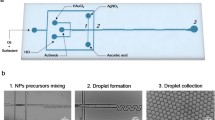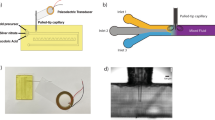Abstract
The synthesis of gold nanostructures with unique architectures has attracted a great deal of attention because of their architecture-dependent sensing, optical, and electrical properties. Gold nanodendrites with a tailored morphology have unique properties due to their enhanced surface areas caused by nanoscale branches. Although gold nanodendrites have been synthesized by many different methods, controllable and high-yield synthesis of gold nanodendrites remains a challenge. Here, for the first time, we show that multi-branched gold nanodendrite synthesis can be controlled using a dynamic microfluidic flow system with high yield and fluid dynamics that control the branching structure of the nanodentrites. The study shows that the architecture of the gold nanodendrites mainly depends on synthesis conditions such as flow dynamics, HAuCl4 concentration, and reaction time. Dendrites grew faster when the flow rate reached 3 µL min−1. We further show that by using microfluidic-assisted synthesis, simple and rapid gold nanodendrite length tuning (0.7 cm) is possible with a threefold branching and textured structure. It is shown that the growth of gold nanodendrites is significantly enhanced (1.7 times faster) under flow conditions in the microfluidic channel. This bottom-up method reduces undesirable effects related to the poor control of static growth and increased reproducibility. Such highly controllable and inexpensive microfluidic flow systems could potentially be used to fabricate high-yield gold nanodendrites for bioelectronics and sensing applications.






Similar content being viewed by others
References
Piella J, Bastús NG, Puntes V (2016) Size-controlled synthesis of sub-10-nanometer citrate-stabilized gold nanoparticles and related optical properties. Chem Mater 28:1066–1075
Helmi S, Ziegler C, Kauert DJ, Seidel R (2014) Shape-controlled synthesis of gold nanostructures using DNA origami molds. Nano Lett 14:6693–6698
Samal AK, Polavarapu L, Rodal-Cedeira S, Liz-Marzán LM, Pérez-Juste J, Pastoriza-Santos I (2013) Size tunable Au@ Ag core–shell nanoparticles: synthesis and surface-enhanced raman scattering properties. Langmuir 29:15076–15082
Demir US, Shahbazi R, Calamak S, Ozturk S, Gultekinoglu M, Ulubayram K (2018) Gold nano-decorated aligned polyurethane nanofibers for enhancement of neurite outgrowth and elongation. J Biomed Mater Res Part A 106:1604–1613
Shahbazi R, Asik E, Kahraman N, Turk M, Ozpolat B, Ulubayram K (2017) Modified gold-based siRNA nanotherapeutics for targeted therapy of triple-negative breast cancer. Nanomedicine 12:1961–1973
Zhang A, Lieber CM (2015) Nano-bioelectronics. Chem Rev 116:215–257
Inci F, Filippini C, Baday M, Ozen MO, Calamak S, Durmus NG et al (2015) Multitarget, quantitative nanoplasmonic electrical field-enhanced resonating device (NE2RD) for diagnostics. Proc Natl Acad Sci 112:E4354–E4363
Baday M, Calamak S, Durmus NG, Davis RW, Steinmetz LM, Demirci U (2016) Integrating cell phone imaging with magnetic levitation (i-LEV) for label-free blood analysis at the point-of-living. Small 12:1222–1229
Abdellatif M, Abdelrasoul G, Scarpellini A, Marras S, Diaspro A (2015) Induced growth of dendrite gold nanostructure by controlling self-assembly aggregation dynamics. J Colloid Interface Sci 458:266–272
Uematsu T, Baba M, Oshima Y, Tsuda T, Torimoto T, Kuwabata S (2014) Atomic resolution imaging of gold nanoparticle generation and growth in ionic liquids. J Am Chem Soc 136:13789–13797
Qin Y, Song Y, Sun N, Zhao N, Li M, Qi L (2008) Ionic liquid-assisted growth of single-crystalline dendritic gold nanostructures with a three-fold symmetry. Chem Mater 20:3965–3972
Zhao P, Li N, Astruc D (2013) State of the art in gold nanoparticle synthesis. Coord Chem Rev 257:638–665
Huang J, Han X, Wang D, Liu D, You T (2013) Facile synthesis of dendritic gold nanostructures with hyperbranched architectures and their electrocatalytic activity toward ethanol oxidation. ACS Appl Mater Interfaces 5:9148–9154
Ndokoye P, Li X, Zhao Q, Li T, Tade MO, Liu S (2016) Gold nanostars: benzyldimethylammonium chloride-assisted synthesis, plasmon tuning, SERS and catalytic activity. J Colloid Interface Sci 462:341–350
Brankovic S, Wang J, Adžić R (2001) Metal monolayer deposition by replacement of metal adlayers on electrode surfaces. Surf Sci 474:L173–L179
Brankovic S, McBreen J, Adžić R (2001) Spontaneous deposition of Pd on a Ru (0001) surface. Surf Sci 479:L363–L368
Calamak S, Aksoy EA, Erdogdu C, Sagıroglu M, Ulubayram K (2015) Silver nanoparticle containing silk fibroin bionanotextiles. J Nanopart Res 17:87
Van Brussel M, Kokkinidis G, Vandendael I, Buess-Herman C (2002) High performance gold-supported platinum electrocatalyst for oxygen reduction. Electrochem Commun 4:808–813
Van Brussel M, Kokkinidis G, Hubin A, Buess-Herman C (2003) Oxygen reduction at platinum modified gold electrodes. Electrochim Acta 48:3909–3919
Passoni L, Criante L, Fumagalli F, Scotognella F, Lanzani G, Di Fonzo F (2014) Self-assembled hierarchical nanostructures for high-efficiency porous photonic crystals. ACS Nano 8:12167–12174
Calamak S, Aksoy EA, Ertas N, Erdogdu C, Sagıroglu M, Ulubayram K (2015) Ag/silk fibroin nanofibers: effect of fibroin morphology on Ag + release and antibacterial activity. Eur Polym J 67:99–112
Wang J, Jin M, Gong Y, Li H, Wu S, Zhang Z et al (2017) Continuous fabrication of microcapsules with controllable metal covered nanoparticle arrays using droplet microfluidics for localized surface plasmon resonance. Lab Chip 17:1970–1979
Puigmartí-Luis J (2014) Microfluidic platforms: a mainstream technology for the preparation of crystals. Chem Soc Rev 43:2253–2271
Lazarus LL, Yang AS-J, Chu S, Brutchey RL, Malmstadt N (2010) Flow-focused synthesis of monodisperse gold nanoparticles using ionic liquids on a microfluidic platform. Lab Chip 10:3377–3379
Huang H, Du Toit H, Besenhard MO, Ben-Jaber S, Dobson P, Parkin I, et al (2018) Continuous flow synthesis of ultrasmall gold nanoparticles in a microreactor using trisodium citrate and their SERS performance. Chem Eng Sci 189:422–430
Fu Q, Ran G, Xu W (2015) A microfluidic-based controllable synthesis of rolled or rigid ultrathin gold nanoplates. RSC Adv 5:37512–37516
Kumar DR, Kulkarni A, Prasad B (2014) Microfluidic platform for continuous flow synthesis of triangular gold nanoplates. Colloids Surf A 443:149–155
Çalamak S, Erdoğdu C, Özalp M, Ulubayram K (2014) Silk fibroin based antibacterial bionanotextiles as wound dressing materials. Mater Sci Eng C 43:11–20
Mutlu G, Calamak S, Ulubayram K, Guven E (2018) Curcumin-loaded electrospun PHBV nanofibers as potential wound-dressing material. J Drug Deliv Sci Technol 43:185–193
Kara F, Aksoy EA, Calamak S, Hasirci N, Aksoy S (2016) Immobilization of heparin on chitosan-grafted polyurethane films to enhance anti-adhesive and antibacterial properties. J Bioact Compat Polym 31:72–90
Kocal GC, Güven S, Foygel K, Goldman A, Chen P, Sengupta S et al (2016) Dynamic microenvironment induces phenotypic plasticity of esophageal cancer cells under flow. Sci Rep 6:38221
Li N, Zhao P, Astruc D (2014) Anisotropic gold nanoparticles: synthesis, properties, applications, and toxicity. Angew Chem Int Ed 53:1756–1789
Ahmed W, Kooij ES, Van Silfhout A, Poelsema B (2010) Controlling the morphology of multi-branched gold nanoparticles. Nanotechnology 21:125605
Shin Y, Lee C, Yang M-S, Jeong S, Kim D, Kang T (2014) Two-dimensional hyper-branched gold nanoparticles synthesized on a two-dimensional oil/water interface. Sci Rep 4:6119
Liz-Marzán LM (2006) Tailoring surface plasmons through the morphology and assembly of metal nanoparticles. Langmuir 22:32–41
Cao C, Zhang J, Wen X, Dodson SL, Dao NT, Wong LM et al (2013) Metamaterials-based label-free nanosensor for conformation and affinity biosensing. ACS Nano 7:7583–7591
Imai H (2006) Self-organized formation of hierarchical structures. Biomineralization I. Springer, Berlin, pp 43–72
Guermonprez C, Michelin S, Baroud CN (2015) Flow distribution in parallel microfluidic networks and its effect on concentration gradient. Biomicrofluidics 9:054119
Trachsel F, Günther A, Khan S, Jensen KF (2005) Measurement of residence time distribution in microfluidic systems. Chem Eng Sci 60:5729–5737
Stone HA, Kim S (2001) Microfluidics: basic issues, applications, and challenges. AIChE J 47:1250–1254
Noh D, Koh Y, Kang I (1998) Numerical solutions for shape evolution of a particle growing in axisymmetric flows of supersaturated solution. J Cryst Growth 183:427–440
Chen M, Ji X, Xu X, Zheng Y, Qian P, Wang Z (2014) The effect of the shear flow on particle growth in the undercooled melt. J Cryst Growth 401:116–119
Author information
Authors and Affiliations
Corresponding author
Ethics declarations
Conflicts of interest
The authors declare that they have no conflict of interest.
Additional information
Publisher's Note
Springer Nature remains neutral with regard to jurisdictional claims in published maps and institutional affiliations.
Electronic supplementary material
Below is the link to the electronic supplementary material.
Rights and permissions
About this article
Cite this article
Calamak, S., Ulubayram, K. Controlled synthesis of multi-branched gold nanodendrites by dynamic microfluidic flow system. J Mater Sci 54, 7541–7552 (2019). https://doi.org/10.1007/s10853-019-03403-0
Received:
Accepted:
Published:
Issue Date:
DOI: https://doi.org/10.1007/s10853-019-03403-0




